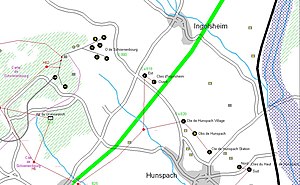Ouvrage Schoenenbourg
| Ouvrage Schoenenbourg | |
|---|---|
| Part of Maginot Line | |
| Northeast France | |

Ammunition entrance, Block 7
|
|
| Coordinates | 48°58′00″N 7°54′43″E / 48.96667°N 7.91194°E |
| Site information | |
| Controlled by | France |
| Open to the public |
Yes |
| Condition | Preserved |
| Site history | |
| Built by | CORF |
| Materials | Concrete, steel, deep excavation |
| Battles/wars | Battle of France, Lorraine Campaign |
| Ouvrage Schoenenbourg | |
|---|---|
| Type of work: | Large artillery work (Gros ouvrage) |
|
sector └─sub-sector |
Fortified Sector of Haguenau └─Péchelbronn |
| Work number: | O 800 |
| Constructed: | 1932 |
| Regiment: | 22nd Fortress Infantry Regiment (RIF), 156thPosition Artillery Regiment (RAP) |
| Number of blocks: | 8 |
| Strength: | 17 officers, 490 enlisted |
| Localisation | |
 |
|
Ouvrage Schoenenbourg is a Maginot Line fortification. It is located on the territory of the communes of Hunspach, Schœnenbourg and Ingolsheim, in the French département of Bas-Rhin, forming part of the Fortified Sector of Haguenau, facing Germany. At the east end of the Alsace portion of the Maginot Line, its neighbor is the gros ouvrage Hochwald. It is the largest such fortification open to the public in Alsace. Officially recorded as an historical monument, it retains all its original structural elements. Schoenenbourg was heavily bombarded during the Battle of France in 1940, receiving more enemy ordnance than any other position in France, with no significant damage. In 1945, retreating German troops used explosives to destroy much of the ouvrage. After the war it was fully repaired and placed back into service as part of a program to use Maginot fortifications to resist a potential Warsaw Pact advance through Europe. By the 1970s the plan had lost favor and funding, and Schoenenboug was abandoned. In 1987 a local organization undertook Schoenenbourg's preservation, and today it is open to public visitation.
The site was surveyed by CORF (Commission d'Organisation des Régions Fortifiées), the Maginot Line's design and construction agency; Schoenenbourg was approved for construction in June 1931. The gros ouvrage was intended to receive an additional turret in a second phase of construction, never pursued. Schoenenbourg is arranged as a typical gros ouvrage, with separate entrances for munitions and personnel almost 1,000 metres (3,300 ft) behind the closely grouped main combat blocks. Schoenenbourg lacks the large "M1" central magazine characteristic of most gros ouvrages. A total of 3,000 metres (9,800 ft) of galleries extend between 18 metres (59 ft) and 30 metres (98 ft) below the surface.
Initial plans were on a smaller scale. The original 1929 proposal was for a petit ouvrage, six blocks armed with machine guns and 75mm guns. Blocks were added to the design until the gros ouvrage emerged. Costs in 1931 were estimated at 41.2 million francs. Construction uncovered difficulties with the foundations, resulting in the widespread use of piles under the blocks to stabilize their support, a unique solution in the Line. The major work was completed in 1935, and equipment and armament were fitted in 1936 and 1937. Final completion took place in 1938, marked by difficulties with drainage of water infiltration.
...
Wikipedia

